
To ensure you get accurate cuts on geometric shapes, you want to make sure your fabric is positioned so that the lengthwise grain of the fabric is going through the length of the cutter. But are you one of those quilters who can’t seem to find the lengthwise grain in your fabric? Don’t worry, you’re not alone. Hopefully the following information will help make it much easier for you.
In a nutshell, your fabric's lengthwise grain is important to find in order to ensure the accuracy of your cut when rolling the fabric cutting dies through your GO! or Studio fabric cutters. If you put your fabric through the cutter on the crosswise grain, it may stretch as the die goes through the rollers on the cutter, causing inaccurate cuts. And we all know how unpleasant it is to try and piece together inaccurate cuts.

You don't want to waste any of that beautiful fabric of yours, so a reliable test to make sure you are cutting in the right direction is key. First off, if you have fabric that has the selvage edge on it, then the lengthwise grain runs parallel to the selvage. Therefore, the problem of finding it is solved. However, if you are using scraps or if the selvage has been removed, here is a quick tip to identify the lengthwise grain. Grasp the fabric along one grain with both hands and give it a couple of sharp tugs and listen to the sound it makes. Then grasp along the other grain and tug again. The snapping sound made by the lengthwise grain will be slightly higher pitched than the crosswise grain sound. We promise . . . it works!
Another way to check is to simply tug the fabric on the lengthwise and crosswise grain to see which way stretches the most. Then, put your fabric through the cutter on the side with the least amount of stretch.
If you’re more of a visual person, check out the video demonstration from legendary quilters Ricky Tims and Alex Anderson.
For your own information, please note the types of fabric grain.
Lengthwise Grain (warp threads)
The lengthwise grain runs parallel to the selvages. It’s the strongest grain in your fabric and has very little stretch. This is how your yardage comes off the bolt. Because it is the grain with the least stretch, whenever possible orient your fabric on the lengthwise grain as you place it on your cutting die to achieve the most accurate cuts. Fabric should be laid on your dies on the lengthwise grain.
Crosswise Grain (weft threads)
The crosswise grain runs at a right angle to the selvages. It has more stretch than the lengthwise grain.
Bias Grain
The bias grain runs on a 45º angle to the selvages. It has the most stretch, so it distorts easily. You must be extremely careful when handling the bias. Cutting on the bias grain will distort your cuts. Although perfect for making bias tape and selected bindings (like scalloped edges), it is best to avoid cutting on the bias as much as possible.
And there you have it. Now that you know how to find the lengthwise grain, treat yourself to a day of fabric cutting with no waste.






